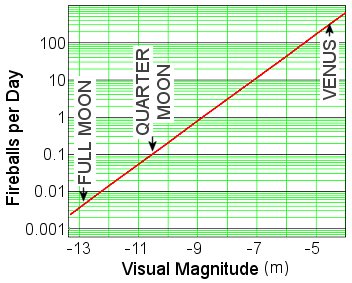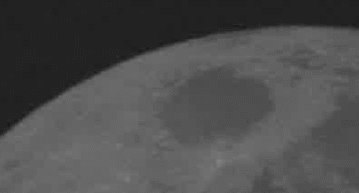 Did you sleep through the auroras of November? Next time get a wake-up call: Spaceweather PHONE.
Did you sleep through the auroras of November? Next time get a wake-up call: Spaceweather PHONE.
PHOTO CONTEST: Photos. Paintings. 3D Anaglyphs: Hundreds of entries to the Transit of Mercury Photo Contest have been judged. And the winners are ... click here.
HOW MANY FIREBALLS? Have you ever stepped outside after dinner to walk the dog--just in time to see a bright fireball streak across the sky? It makes you wonder, how often does that happen?
Pretty often, according to astronomer Bill Cooke of the Marshall Space Flight Center. Using a computer model of Earth's meteoroid environment, he made this plot showing the global number of fireballs per day vs. the brightness of the fireball:

According to his calculations, fireballs as bright as Venus appear somewhere on Earth more than 100 times daily. Fireballs as bright as a quarter Moon occur once every ten days, approximately, and fireballs as bright as a full Moon once every five months.
The vast majority are never noticed. About 70% of all fireballs streak over uninhabited ocean. Half appear during the day, invisible in sunny skies. Many are missed, however, simply because no one bothers to look up. So grab a leash and a dog (optional), and head outside. The chance of a fireball is better than you think.
MEANWHILE ON THE MOON: Meteoroids hit the Moon, too, but they don't stop in the sky. They hit the ground and explode in a flash of heat and light. A team of astronomers led by Bill Cooke at NASA's Marshall Space Flight Center caught this Leonid hitting the Moon on Nov. 17th:

The explosion was about as bright as an 8th magnitude star, an easy target for backyard telescopes. (The NASA group used a 14-inch Meade RCX400.) Remarkably, such a flash occurs about once every four hours. Get the full story from Science@NASA.
BONUS FIREBALL: On Nov. 28th, in a split-second of total coincidence, a meteoroid the same size as the Lunar Leonid plunged to Earth over the Marshall Space Flight Center in Huntsville, AL. What happened? Nothing. It disintegrated harmlessly in the atmosphere. A local security camera captured this movie of the fireball.

